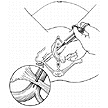During your childbirth experience, you may choose to deliver your baby naturally or you may opt for some type of pain relief.
What pain relief is available?
Demerol: This is a mild anesthetic. This usually gives a calming affect. This may make some women nauseous or nervous. It is administered by being put into your IV. No extra insertion of needles is necessary. Once you receive the Demerol, it should work within 20 minutes.
Epidural: One of the most popular pain relief methods of childbirth. Women who receive the epidural after giving birth naturally are amazed at the relief from pain. This is given with a long, thin, flexible needle right beside the spine and left in place during labor. Many women describe the epidural as a "bee sting" type feeling. If you are having a contraction during this procedure, they can not wait until it is over once they have started. For some women this is why they do not like epidurals. The epidural takes effect about 15 minutes to 1 hour after it is given.
Walking Epidural: This type of epidural allows you to move around more comfortably without as much numbness in the legs. Some women want to be able to get up and go to the bathroom. The walking epidural is not available in all hospitals.
Spinal Block (Saddle Block): This anesthesia is similar to the epidural, but it is administered by a long, thin, flexible needle in the spine.
Pudenial Block (anesthesia to vaginal area): A pudenial block is a local anesthetic used to numb the vaginal area for childbirth and episiotomies. It is sometimes given right before the pushing stage or after the baby is born and the doctor is repairing the episiotomy.




No comments:
Post a Comment